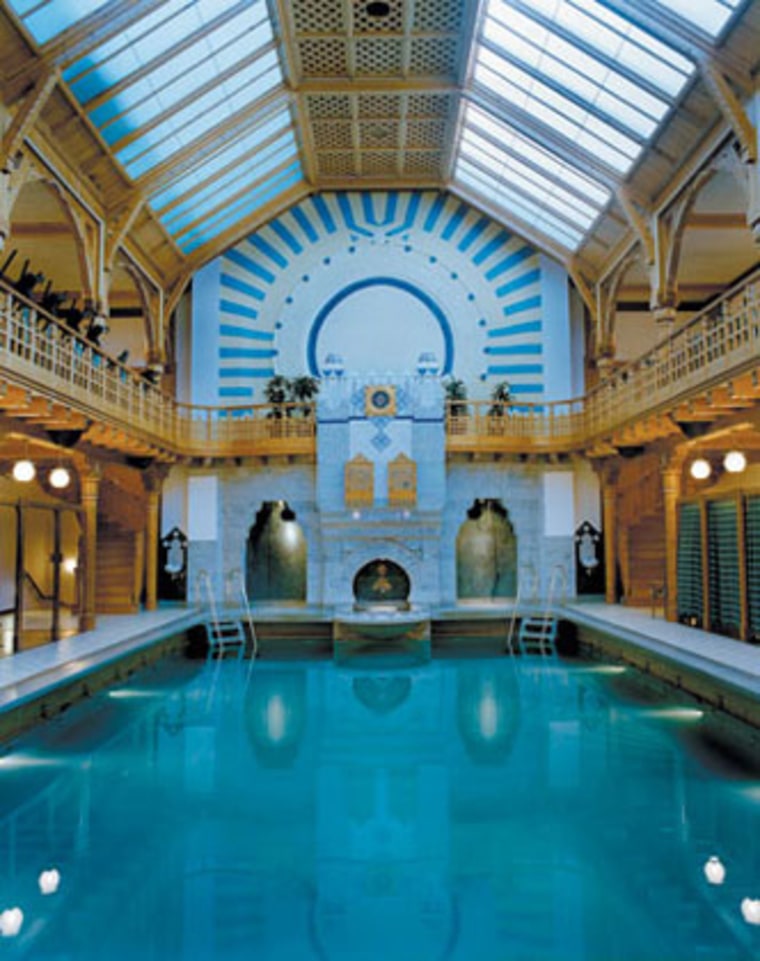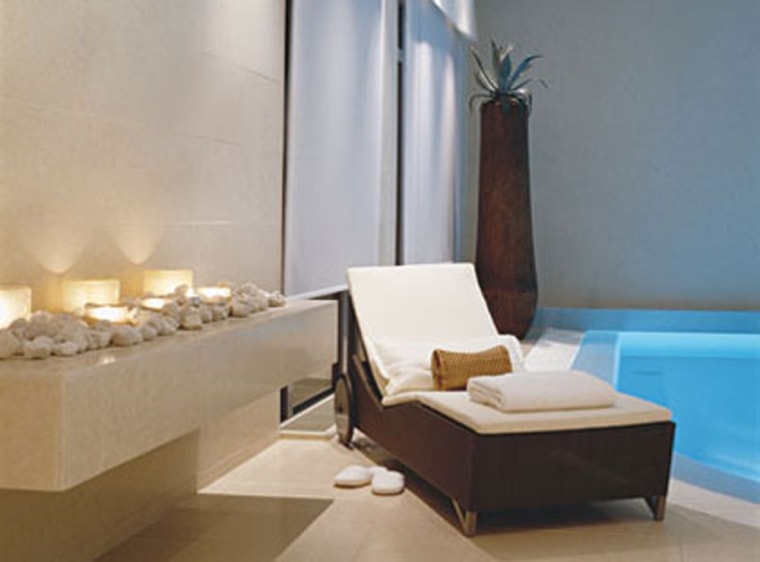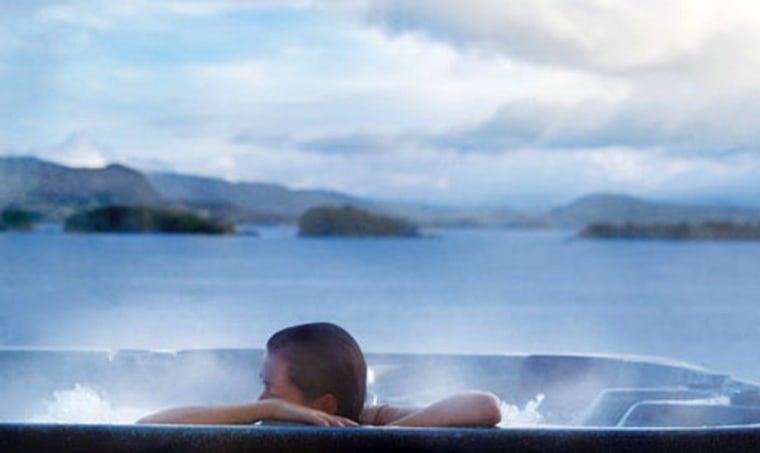Stockholm is beautiful. On a midsummer morning in July, I stare out the glassed breakfast nook of the Grand Hôtel stirring crimson-red lingonberries into creamy muesli and watching mist swirl across fairy-tale buildings. I am surrounded by tall, flaxen-haired, model-esque women and men — who sip coffee and butter toast for their blond, cherub-cheeked children.
“Are you enjoying yourself?” I hear. Somehow, in my musings, I’d missed seeing her come in, the fairest of them all — Swedish skincare icon Kerstin Florian, whose international spa company bears the same name, in residence for the summer. We’d met months before in Phoenix, far from Stockholm’s archipelago seascape, where Florian was rolling out new therapies at the JW Marriott Desert Ridge Resort’s Revive Spa. After receiving a treatment that cocooned me in lavender and sea salt, I sat with her for hours under an umbrella (the desert sun at our backs) talking about what “spa” means and where she finds her inspiration. Every insight — from the famous muds, seaweeds, and salts used in her product line to her steadfast belief that “spa is not a treatment, but a lifestyle” — always circled back to one place. Sweden.
Born and raised in Stockholm, Florian spent summers at her family’s cottage in the Baltic Sea archipelago of Värmdö, where she embraced “the solitude and magic” of the lapping sea and towering birch trees, sacred to Sweden’s native Sami people, who populate the arctic circle region.
“The Sami are very spiritual,” Florian told me. “They anoint their newborn babies with birch-bud oil to cleanse their spirits, and before making an important life decision, stand under a birch tree holding a brass ring to their eye to focus on what they need to see.”
At age 21, Florian (then a print-and-runway model) moved to California, where she got married, raised a family, and launched her now-international skincare company. But each May since, she’s returned to Sweden to spend the summer reconnecting with her roots. “Sweden is where I refill my energy; where I feel most alive,” she told me. “Every year when I arrive, the blossoms are just bursting with color and life, and I say, ‘Are you blossoming, Kerstin? And if the answer is no, then I go into nature, pick mushrooms and berries in the forest, sit under a birch tree and meditate, and swim daily in the sea. In that comes renewal, and that, to me, is spa.” Now, months later, Florian has invited me to experience, firsthand, her au naturel spa.
Our plan for this sunny, almost-80-degree day is to go boating through the archipelagoes — an adored warm-weather pastime in Sweden and Florian’s “absolute favorite thing to do” (aside from spending time with her grandchildren). Dressed for the part, her platinum hair is pulled into a girlish ponytail, dark sunglasses perch upon her head, and she’s in “sailor whites” — cropped pants, canvas shoes, and a V-necked white sweater trimmed in navy. “We had our own boat for years,” she says, zipping in her blue Volvo to Saltsjöbaden, an ancient fishing village. “I miss it, but no worries. In Sweden, when you don’t have a boat, your friend or friend’s friend will take you out. Swedes are boating people. It’s what we do.”

After a 15-minute drive from Stockholm, we arrive at a 52-foot yacht captained by a svelte and deeply tanned 59-year-old Swede named Staffan. “Welcome,” he says as he kisses us on both cheeks. He then turns to me: “And congratulations. You are off to see the most beautiful archipelago in the world, a true slice of heaven.”
After dousing our faces and bodies with sunscreen and slathering moor mud on our feet to bake along the way, we’re off, and within seconds I’m hooked. Purring slowly through narrow channels, we pass white birch trees and traditional wooden houses — ocher-red with black doors and white-trimmed windows — each with a tiny detached sauna house. Mahogany boats with blue-and-yellow Swedish flags billow past — their passengers waving in greeting. In time, the channel widens, houses disappear, and we are in a whirl of blue sea dotted with giant boulders and white swans bobbing gracefully in pairs.
“Since I was a little girl, it has always been this way,” Florian says. “You pull your boat into your favorite place, spread a picnic, swim naked if you like, sunbathe, spend the day. It’s so fresh, so pure — just you, the water, sun, sky, and rocks.”
We troll on, stopping at one point to collect seaweed, which Florian boils in a pot in the galley. Banishing Staffan from view, we smear the green-brown mixture on our bodies and bask in the sun. When our seaweed body masque is hardened, we dive into the cool sea. By the time we reach the last Swedish island before the open Baltic Sea, I’m famished. I see a small sign outside a worn clapboard restaurant that reads “Sandhamn Värdshus, 1672; open every day since.”
“To come way out here, dock the boat, bathe, and then eat the most fabulous meal — fried bass with lingonberries and mashed potatoes accompanied by a nice glass of wine — this, too, is spa,” Florian says, smiling. Hours later on our way back to Stockholm, Staffan anchors the boat once more, and again we dive in. The cold seawater on warm flesh is magical. Hypnotic, even. There are no crowds or noise, nor any reason to rush. The midnight sun means the sky will stay light for hours more, so there’s plenty of time to bob blissfully with the swans — and just be.
“Swedes don’t have as many material things as Americans do, but they are in tune with the simple luxuries and know how to rejuvenate and bring back their shen (energy),” says Florian. “Spa doesn’t have to be so formulated.” Like much of Europe, Scandi-navia’s spa tradition dates back to drinking mineral waters, bathing (for Swedes, in pine and chamomile), and sitting in a sauna. But the modern-day spa scene is relatively new, and Florian is helping to define it. She opened her first Scandinavian spa in 1989 and today has over 100 spas in Sweden; eight in Norway; and six in Denmark (in addition to more than 100 in the U.S.). But although her spirit and energy are evident in all, no two spas are the same; each reflects its own natural landscape.
The following morning, after a delicious sleep on a downy feather bed, I wander (map in hand) from the Grand Hôtel in search of Florian’s newest Stockholm spa, which is located in Sturebadet, a recently renovated bathhouse built in 1885. The spa reopened with great fanfare last spring — its most talked-about feature being a treatment room
based on a traditional Sami kota (tepee). Reindeer skins line the floor, a barrel-shaped bathtub is carved from fragrant pine, and the darkened ceiling, with its twinkling lights, is reminiscent of the northern sky. The room was specifically designed for Florian’s signature Sami Zen treatment — a beautiful 90-minute ritual choreographed to haunting Sami jojk music that includes a scrub, chamomile bath, and massage with birch oil and heated bote stones — polished by the arctic water and ice.
I’m running dangerously close to missing my chance to experience the signature treatment when I realize I’ve passed the spa entrance several times. Who knew the ancient bathhouse would be stylishly tucked inside a high-fashion shopping mall? In 1985, a fire destroyed the original structure, and while this resurrected version no longer has communal bathing, there’s a lovely Turkish bath for private bookings and a 15-room spa — nestled into the womb of the new construction — that pays tribute to Sweden with its sleek lines, all-glass sauna, low-lit candles, and relaxation room featuring a tile mosaic of white birch trees. Following the blissful treatment, my skin fragrant with birch oil, I slip into one of the curvy chaises fronting the mosaic and close my eyes. I could almost be back in the archipelagoes except for one thing: the sounds of other people. Although the spa is on its own floor, Sturebadet — with 2,000 members who live and work in downtown Stockholm — has a health club vibe. And on this particular morning, I can hear music blaring; water aerobics are in full swing. I creep upstairs to find a pool-full of elderly women in bathing caps flailing their arms and singing — in Swedish — to Rod Stewart.

I find no such activity at Solstrand Hotel & Bad, a magical 130-room yellow-gabled property set in the fjords of Western Norway. After a flight from Stockholm to Bergen via Oslo, followed by a 30-minute taxi ride through hilly terrain, I arrive late, nearly 10 p.m., but the sun is still high. Matriarch Børrea Schau-Larsen greets me as she does every guest, and after hand-delivering me to my room, insists I have a light dinner: “Some fish chowder, bread, cheese, yes?” she offers.
Dropping my bags, I fling open the windows to take in the breathtaking fjords — water laps gently against weathered, 100-year-old boathouses; a couple, deep in conversation, strolls among pink-yellow rose bushes and the bonfire Schau-Larsen lights to welcome those arriving in darkness by boat. Solstrand has been family owned since 1929, and for the past few years, Schau-Larsen has been managing the hotel solo and making “subtle” changes — a 13-room Kerstin Florian spa (added in 2003) and, soon-to-come, a row of small bathhouses by the water.
“The fjord is my natural bath,” says Schau-Larsen. “I swim daily, and every Thursday at 6:30 a.m. meet up with a group of women. We sit in the pre-dawn darkness, talk, take a quick walk, and then go into the water. Even in winter, it’s fantastic. With Internet and mobile phones, we all need an oasis. To come out here, have spa treatments and a nice dinner, dive into the fjord — it’s very freeing,” she says. “And to a Norwegian, freedom defines luxury.”
Throughout the spa, the tie to nature is strong. Floors are blond hardwood, a fireplace burns even in summer, and treatment rooms are paint-splashed with buttery yellow and sienna orange hues. An all-glass sauna and glassed-in yoga room overlook the fjords, while nautical references (a heavy sailor’s rope, an old canoe) mindfully recall the history of the place and its people. Spa treatments, too, draw from nature. “I’ve been in many commercial spas but never felt well in any of them,” says Schau-Larsen. “The treatments here, culled from mud, salt, and seaweed, are about health. They’re very pure, very healing.” Pure is once again how I feel after Agnethe, my therapist, wraps me in Florian’s warming moor mud, slathers my face in a mud masque, massages my body with lavender oil, and then leaves me to sit, meditatively, by the fjords.
A sense of purity was also the characteristic that hotelier Tone Skjellaug set out to embody in Kerstin Florian’s exclusive spa in Geilo, Norway, a popular 100-year-old ski town located exactly halfway between Bergen and Oslo (an easy three-hour, scenic train ride from both). Six years ago, Skjellaug and her husband purchased a tired hotel “in dire need of a redo” and rechristened it Vestlia Resort. Using Aspen as inspiration, the couple transformed the property into a hip lodge with dark woods, chocolate-hued furniture, original artwork, and a low-lit bar. Vestlia’s new nine-room spa, added in 2005, is equally moody, with the same dark hardwood floors and flickering candles.
“We wanted spa guests to feel cocooned and nurtured,” says Skjellaug. “Spa treatments — from the neck down — are still very new in Norway. Norwegians know facials — we spend more on cosmetics than anyone else in the world. But the concept of ‘going to a spa’ is still relatively new. Norwegians have become very wealthy. We travel a lot, spend a lot, and have a very high standard of living. But we are also increasingly stressed, and so we need to breathe and relax, and in that way, the idea of a spa is very acceptable. But fluff treatments will never fly here. Natural ingredients and being in nature are too important.”
And, for me, addictive. After being ensconced in the spa for several hours for my Vestlia Relax — a combination salt scrub, seaweed wrap, and massage — I find myself gravitating, almost instantly, back outdoors to the midnight sun. A narrow trail leads from the hotel to a giant lake framed by towering birch trees and purple flowers. I walk for hours past brightly painted houses, some with sod roofs; fly fishermen wading in hip-high boots; and bursting fields of colorful wildflowers. It is only when my feet, inappropriately clad in flip-flops, begin to ache that I check my watch (it’s nearing 10 p.m.) and make my way back. Rounding the last bend, the sky darkening as a misty fog rises from the lake, I stop, breathe deeply, and savor the fresh mountain air and solitude of the forest. Only five days in Scandinavia and my shen has returned. I am renewed. “Blossoming,” as Kerstin Florian would say. “This is spa.”
